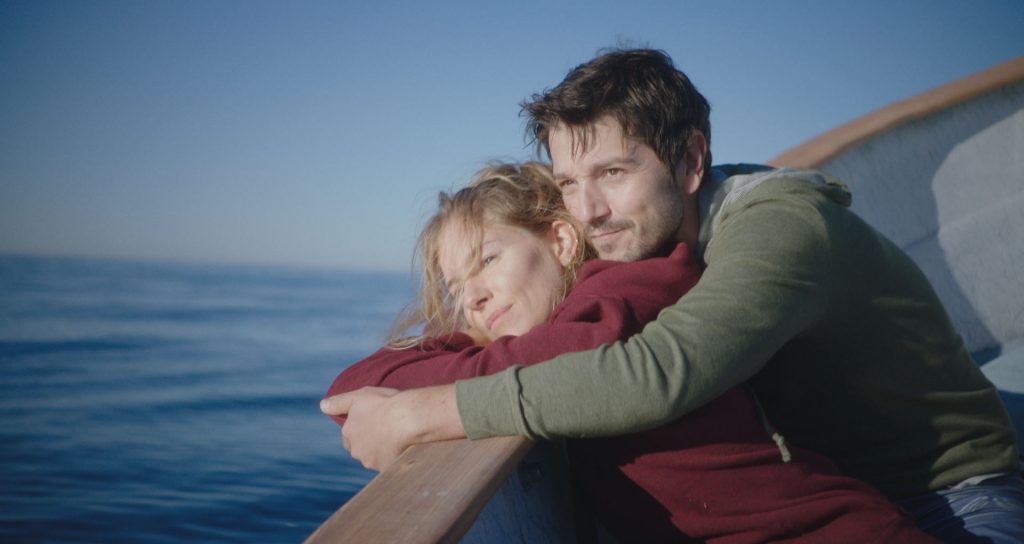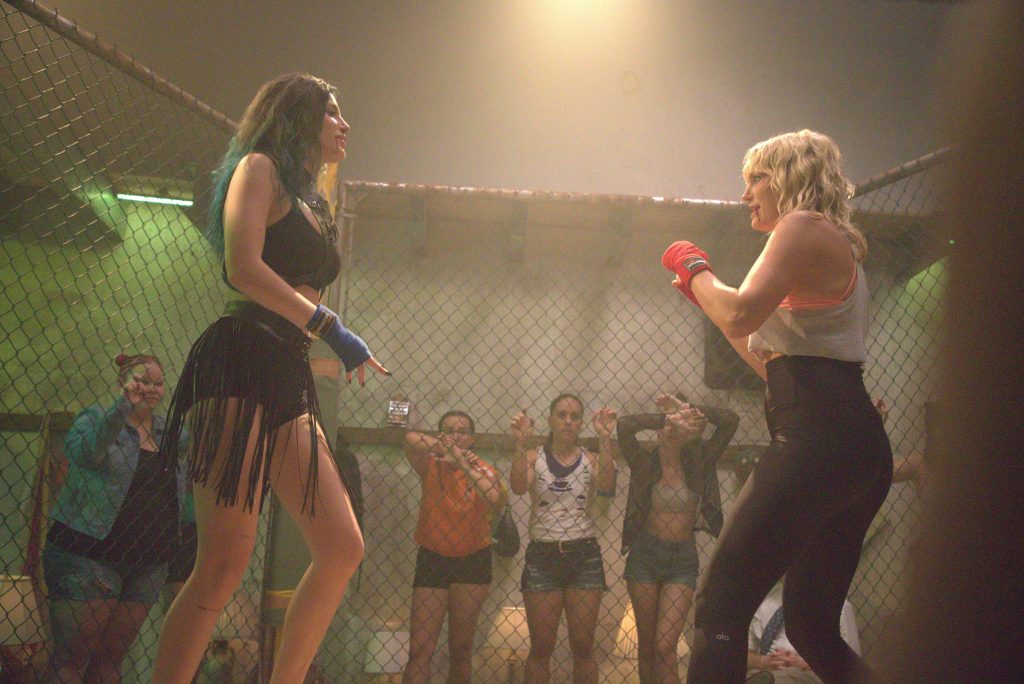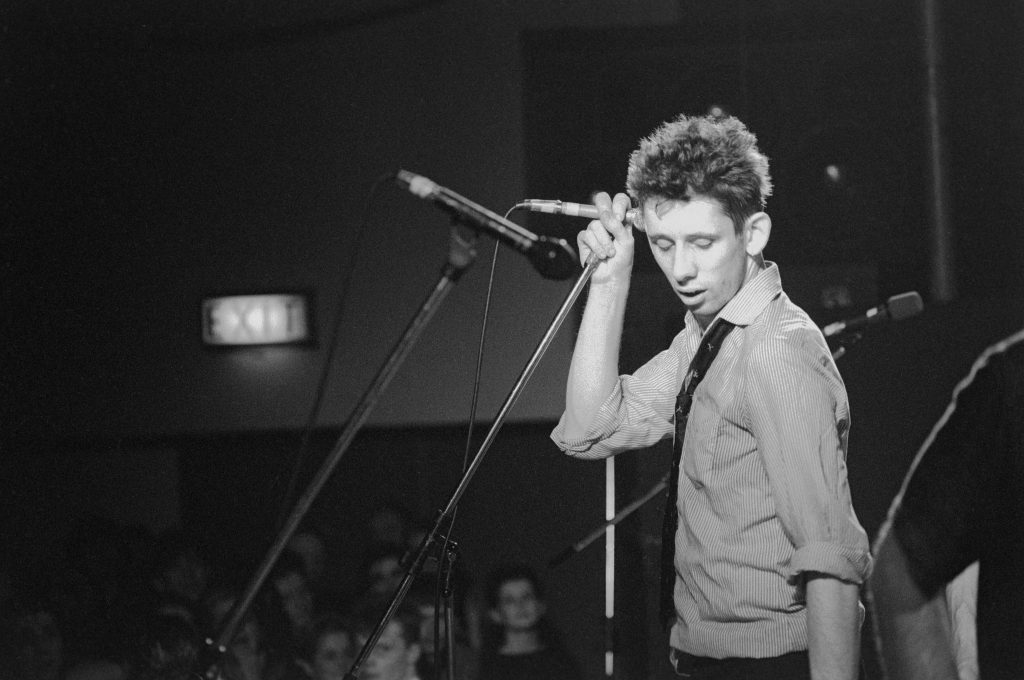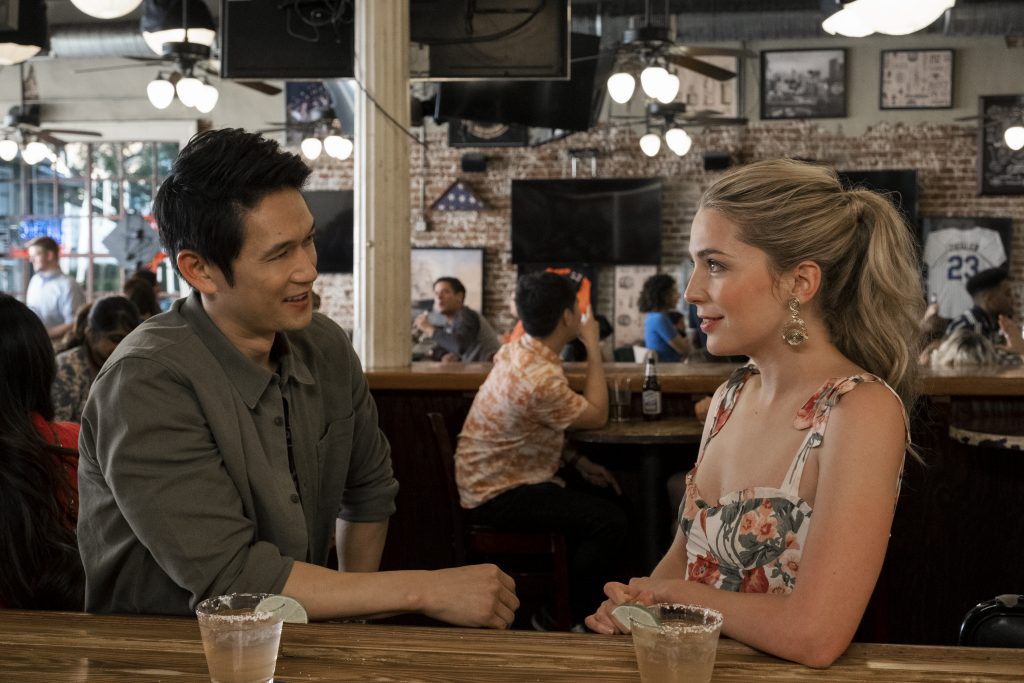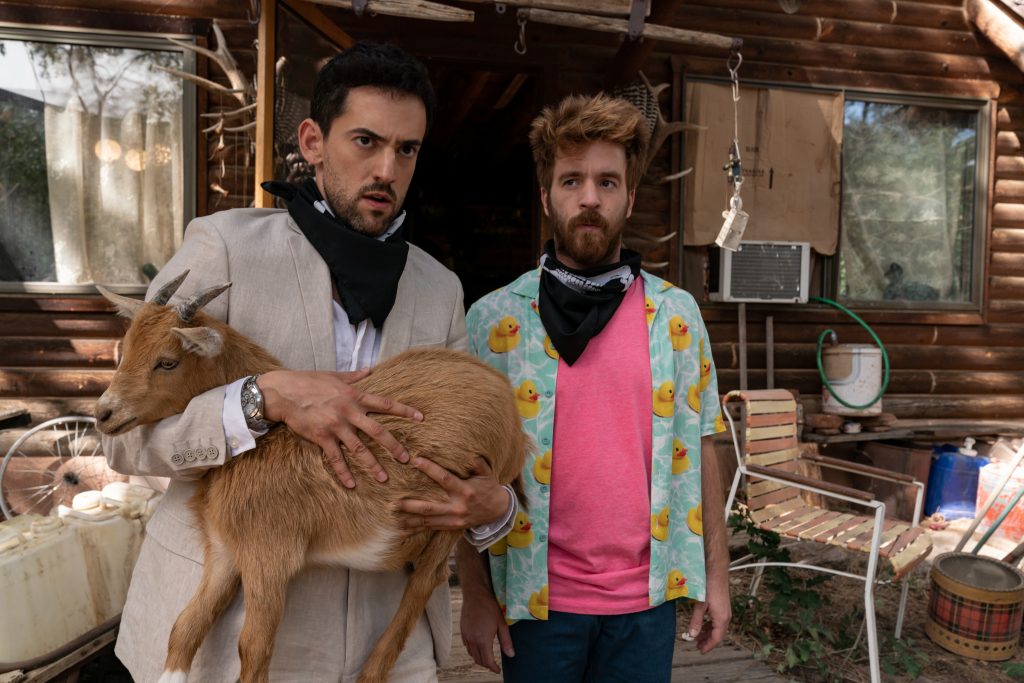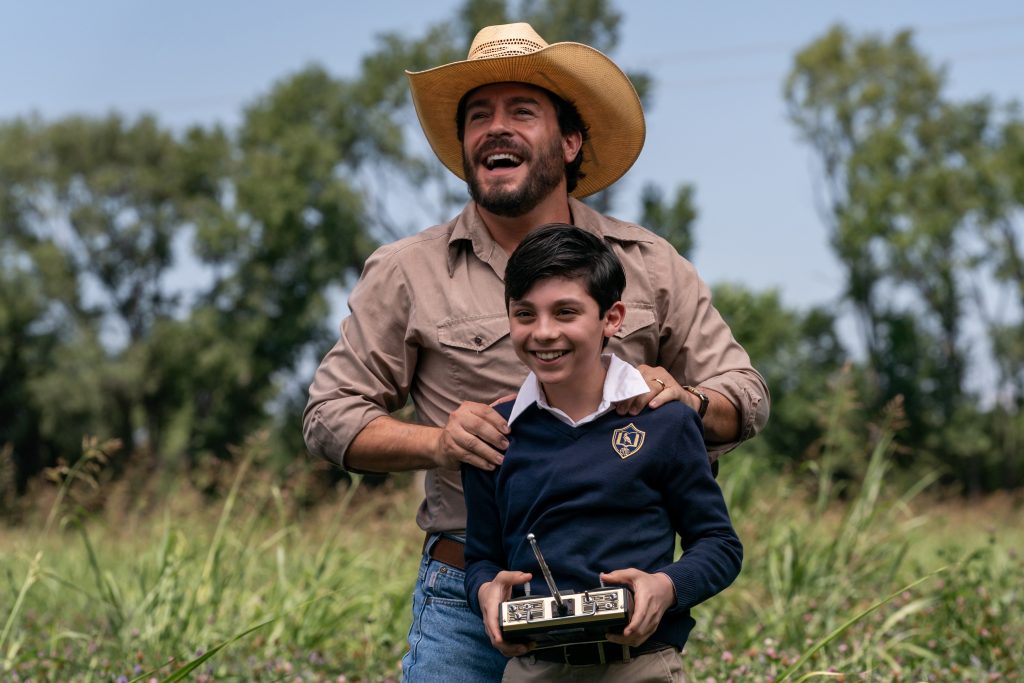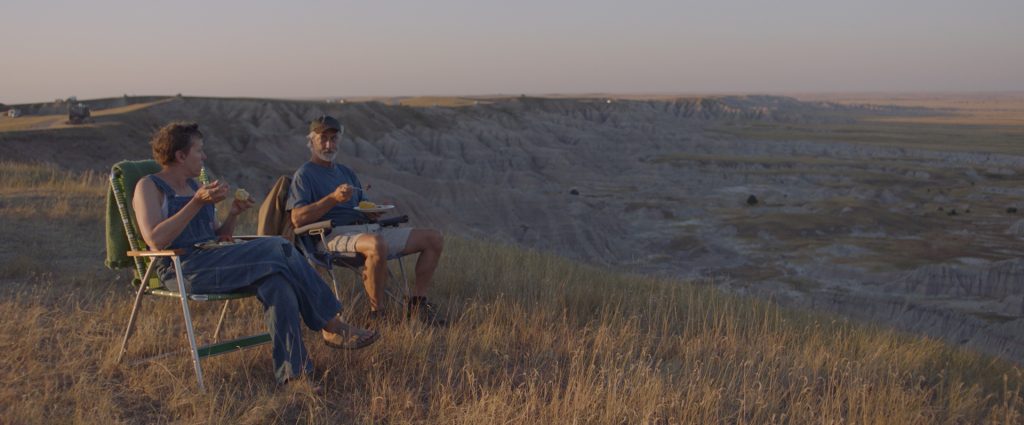December 11, 2020
by Carla Hay

Directed by John Patrick Shanley
Culture Representation: Taking place in Ireland and in New York City, the romantic drama “Wild Mountain Thyme” has an all-white cast of characters representing the working-class, middle-class and wealthy.
Culture Clash: Two oddball Irish farmers—one female and one male—have very different views of love and marriage, while the male famer’s rich American businessman cousin might be part of a love triangle for this would-be couple.
Culture Audience: “Wild Mountain Thyme” will appeal primarily to people who don’t mind watching romantic movies that are pretentious and ridiculous.

The production notes for “Wild Mountain Thyme” describe the movie as a “comedic, moving and wildly romantic tale.” Comedic? The reality is that “Wild Mountain Thyme” is a drama with a lot of unintentionally so-bad-it’s-funny moments. Moving? This painfully dull movie doesn’t pour on the sentimental sap until the last 15 minutes of the film—and it does so in the corniest way possible. Wildly romantic? The characters in “Wild Mountain Thyme” are so dysfunctional and/or emotionally repressed that there’s almost no passionate romance in the film, and the characters spend most of the movie bickering about land ownership and who’s a legitimate farmer.
“Wild Mountain Thyme,” which takes place mostly in Ireland and partially in New York City, was written and directed by John Patrick Shanley, who adapted the movie from his 2014 Broadway play “Outside Mullingar.” Even though Shanley has won an Oscar (for writing 1987’s “Moonstruck”) and a Tony and a Pulitzer (for the play “Doubt: A Parable”), those prestigious awards don’t mean that someone is incapable of making an embarrassing stinker. “Wild Mountain Thyme” is an overly verbose story that ultimately doesn’t have much to say and should have remained on the stage, where pretentiously worded dialogue is expected and therefore much more palatable than it is for a movie audience.
“Wild Mountain Thyme” (which was filmed primarily in Mayo County, Ireland) gets its name because there are scenes in the movie where people sing “Wild Mountain Thyme” in a pub. The cinematic version of the story also greatly benefits from showcasing the lush and gorgeous landscape of rural Ireland. There’s no denying that the film’s cinematography by Stephen Goldblatt is one of the movie’s few high points.
But right from the start, the tone of “Wild Mountain Thyme” is off-kilter, by having a dead character as the movie’s intermittent guide/storyteller. There’s voiceover narration from Irish farmer Tony Reilly (played by Christopher Walken, doing his usual eccentric schtick) explaining how the would-be couple at the center of the story first came to know each other. Tony announces at the beginning of the narration that he’s dead, so people will know that they’re supposed to be hearing the voice of a ghost. Very morbid.
Tony says, “They say if an Irish man dies while telling a story, you can rest assured, he’ll be back.” This movie is so unimaginative that, sure enough, toward the end of the film, Tony’s voice comes back into the narration to repeat the same line. The narration is really unnecessary because Tony doesn’t provide any insight that isn’t already presented in the movie characters’ actions.
“Wild Mountain Thyme” producer Martina Nilan is quoted in the movie’s production notes as saying that “Wild Mountain Thyme” is “a timeless fable with a heightened fairy-tale tone.” However, the movie isn’t timeless and actually is very outdated with its old-fashioned views of strict gender roles for men and women when it comes to love and romance. Based on what the “Wild Mountain Thyme” characters say and how they act, they believe that women’s ultimate goal in life should be to get married and have children, and women have to wait until men make the first move in a courtship.
The movie also has the sexist notion that women who’ve never been married by a certain age have to be desperate to get married. “Wild Mountain Thyme” also pushes a narrative that a woman isn’t considered a “real woman” unless she wants to become a mother or is a mother. Meanwhile, men who’ve never been married and have no kids by a certain age might be considered “strange,” but they don’t have to be desperate to find a spouse.
It’s this moldy concept that stinks up the “will they or won’t they” relationship of Rosemary Muldoon (played by Emily Blunt) and Anthony Reilly (played by Jamie Dornan), two Irish farmers who embody the old-fashioned stereotypes of what usually happens in romantic dramas: The woman wants to be romanced by the man and be in a committed relationship with him that leads to marriage, while the man spends almost the entire story resisting. In other words, the man always has the “upper hand,” because he’s the one who decides if there will be a romantic relationship or not.
The movie sticks to this formula like patriarchal glue. There’s nothing inherently wrong with a story about falling in love and wanting to get married and have kids. But the way this story is told in “Wild Mountain Thyme” is extremely off-putting because the filmmakers want to pretend that it’s a feminist movie, when it’s just the opposite. For almost the entire movie, Rosemary mopes around and sulks because she’s waiting for Anthony to show a sign that he wants more than a platonic relationship.
As Anthony’s dead father Tony explains in the narration, Rosemary has been in love with Anthony since they were both 10 years old. (In flashbacks, Abigail Coburn plays a young Rosemary, while Darragh O’Kane plays a young Anthony.) The Reilly family and Muldoon family are farmers who live right next door to each other in rural Ireland, so the kids grew up knowing nothing but life on a farm.
The adult Rosemary and Anthony in this story are now in their late 30s. Because of Tony’s ghostly narration, this entire story is a flashback. Tony’s death and funeral are eventually shown in the movie.
The Muldoon family owns a strip of land that overlaps into the entrance of the Reilly family’s home. Tony tries in vain to get the Muldoon family to sell that strip of land to him. The questions over who owns this strip of land and who will inherit the entire Reilly family property are sources of contention throughout the story.
Anthony’s widower father Tony wants Anthony to inherit the farm. However, Tony is having doubts about his son’s ability to handle the responsibility because Anthony is an emotionally immature loner who doesn’t seem very smart about the business side of running the farm. Tony also disapproves of Anthony not showing any interest in getting married and having kids, while Anthony is extremely unwilling to become a husband and father. In fact, Anthony shows no interest in having a committed relationship with anyone.
What’s odd is that later in the story, Tony mentions Anthony’s two other siblings: Trish and Audrey, who are never seen or heard in the film. It’s implied that these two sisters are still alive somewhere. But because the movie has a sexist tone to it, these female characters are easily dismissed and never mentioned again, as if Anthony is the only rightful heir in the family.
Tony’s wife Mary (played by Clare Barrett), who died when the children were young, is also sidelined. She’s only seen briefly in flashbacks, where she’s cheerfully singing or cooking in the kitchen by herself, with no lines of dialogue. Considering this film’s sexist attitude about women only existing to be wives and mothers, it’s no wonder that Mary is only seen in the kitchen.
At one point in the movie, Tony admits to Anthony that he married Mary out of loneliness, not out of love, but that Tony eventually came to appreciate his wife, who was the one who pushed for them to get married in the first place. It’s an obvious parallel to what’s going on with Rosemary and Anthony. The only time that Anthony mentions his mother is when he tells Rosemary: “When my mother died, I couldn’t see colors anymore.” Cue the violins.
Rosemary is an only child who lives with her widowed and very opinionated mother Aoife (played by Dearbhla Molloy), who also wants Rosemary to get married and start her own family. But Rosemary is pining over an emotionally stunted Anthony, because she thinks he’s “the one.” Aoife (who affectionally calls Rosemary “mad,” as in crazy) also thinks that Anthony is a good match for Rosemary, but you get the impression that Aofie mainly wants to see Rosemary become a wife and mother to any suitable man who might come along.
Rosemary won’t come right out and tell Anthony that she has romantic feelings for him because she expects him to do the “manly” thing and make the first move and ask her out on a date. When Anthony tells her that he’ll never get married, she says that she doesn’t believe him. Rosemary even tells Anthony that she will have her eggs frozen if necessary, until he comes around to the idea of being her husband and the father of her children. But Anthony just acts confused and slightly repulsed (apparently he’s ignorant about modern fertility treatments) and tries to ignore Rosemary’s desperation.
In a flashback to Rosemary’s childhood as a 10-year-old, she’s doing what she usually does in this movie: pouting and obsessing over Anthony. Her father Chris (played by Don Wycherley) notices Rosemary sulking at the kitchen table. She tells her father in a depressed voice: “I’m just a girl. The world is full of girls.”
Her father responds by saying, “You’re not just a girl … You’re a queen … You are the white swan … It means no one can top you. The world is yours. You can do anything.”
Because of this little pep talk, Rosemary becomes fascinated with the ballet “Swan Lake.” There are several references to “Swan Lake” throughout the movie. And these “Swan Lake” references are as cloying and sappy as you might think they are.
In the beginning of the movie, which jumps around in flashbacks throughout the film, Chris has died, so viewers don’t really get to see the relationship that Rosemary had with Chris when she was an adult. However, Rosemary is very close to her mother, who can often get on Rosemary’s nerves with nagging about Rosemary being a spinster. However, no one puts more pressure on Rosemary to become a wife and mother than Rosemary herself.
There’s also a hint that Tony has been attracted to Aofie for quite some time, but he didn’t act on that attraction because she was married. Not long after Chris’ funeral, Tony doesn’t waste time in flirting with Aofie and making it clear that he’d like to get to know her better if she’s interested. Thankfully, that potentially awkward storyline goes nowhere.
After Chris’ death, Rosemary has fully taken over the Muldoon farm’s operations. Of course, the movie doesn’t actually show her doing much dirty work on the farm, since the filmmakers want to confine Rosemary in the stereotypical role of woman who’s mainly concerned with getting an uninterested man to be her husband. There are some scenes with some adorable animals though, with the predictable cute “reaction” shots of an expressive pet dog who seems to know what the humans are saying and has the head tilt and emotional eyes to prove it.
In the ghostly narration, Tony describes Rosemary as being “besotted with love,” which will make viewers wonder if Rosemary’s obsession with Anthony is true love or if she’s just in love with the idea of being married and having her own family. The filmmakers try to make Rosemary look like a moody, tobacco-smoking feminist (she smokes cigarettes and pipes), but she’s really just a run-of-the-mill “damsel in distress” who’s waiting around for a sour and grumpy Anthony to rescue her from her loneliness.
In addition to the cliché of a desperate woman longing for an emotionally unavailable man, “Wild Mountain Thyme” has another over-used cliché in movies about romance: the possibility of a love triangle. It starts from Rosemary and Anthony’s childhood, when there are a few brief scenes of a character named Fiona (played by Anna Weekes), whom Rosemary sees as a threat for Anthony’s affections. It’s mentioned that in her childhood, Rosemary even got into a physical fight with Fiona, by pushing her down. The adults didn’t do much about it but give Rosemary a mild scolding.
However, just like all the female characters with supporting roles in the movie, Fiona only seems to be there for filler and not to further the story in any way. When Anthony and Rosemary are adults, there is a brief reference to Fiona when Anthony mentions to Rosemary that he saw Fiona by chance somewhere and he had brief conversation with her. (Anthony and Fiona’s conversation is never shown in the movie.) Rosemary gets visibly jealous when she hears that Anthony and Fiona were in contact with each other.
There’s a brief scene that shows Anthony is interested in dating women when he has a drunken encounter with a pretty but scruffy blonde named Eleanor (played by Lydia McGuinness), who’s got spiky and messy hair styled like the ’80s female pop trio Bananarama. Anthony and Eleanor meet in a pub, get drunk together, and hang out on a ledge, where she confesses some sordid sexual secrets to him. She’s so tipsy that she loses her balance and falls off of the ledge. Eleanor is never seen again in the movie.
The main love triangle in the story is between Anthony, Rosemary and Adam (played by Jon Hamm), who is the American son of Tony’s brother. Adam is a single, successful money manager in New York City, because apparently the “Wild Mountain Thyme” filmmakers want to shut out any possibility that there are plenty of eligible bachelors in Ireland who could catch Rosemary’s fancy. Adam, who is very brash and confident, loves to flaunt his wealth. And by his own admission, Adam relishes being the center of attention.
Because Tony has doubts about Anthony’s ability to take care of the farm, he tells Anthony that he’s contemplating having Adam inherit the farm, even though Adam has no experience in farming. However, Tony is impressed with Adam’s business skills and he thinks the farm has a better chance of thriving if Adam took over the operations.
And so, Adam is invited to Ireland to look over the farm. Adam thinks of himself as someone who can easily be a farmer, because it’s something that he’s been fantasizing about for a while. However, it’s clear as soon as Adam comes to visit, he’s really a city dweller at heart. He wants to own the farm, not be an actual farmer.
Because he’s a showoff, Adam drives up to the farm one day in a silver Rolls Royce, which greatly impresses Tony. Meanwhile, Anthony is naturally feeling overshadowed and unappreciated when Adam is around. Anthony makes a point of telling Adam that he’s not a real farmer. The business-minded Adam is appalled that Anthony and Rosemary don’t know how many acres of farm land that they have.
It isn’t long before Adam shows that he’s attracted to Rosemary. The feeling isn’t really mutual, but Rosemary likes the attention, which is something that she doesn’t get from Anthony. Whereas Anthony can’t even be bothered to go over to the Muldoon house to visit Rosemary (even though she lives next door), Adam eagerly invites Rosemary to visit New York City, within a few hours of meeting her. Rosemary tells Adam that she’d love to go to the theater in New York. And this is the point in the movie where viewers can predict that if Rosemary does ever go to visit Adam in New York, you know exactly which stage production she’ll want to see.
Meanwhile, whenever Anthony gets irritated with Rosemary (which is often), he tells her that she should think about selling the farm and that she should leave Ireland. She usually replies in a huff that maybe she will leave. But she’s not fooling anyone. Rosemary is too obsessed with Anthony to leave.
Anthony occasionally mentions that he’s thinking about leaving farm life behind too. At one point, he makes a very un-patriotic comment about Ireland: “It’s a terrible place for a decent person.” Anthony, who keeps telling people that he thinks he’s “mad” (as in mentally ill), is also somewhat of a social outcast in the community.
Anthony’s oddball reputation is further fueled after an incident when a neighbor named Cleary (played by Barry McGovern) sees Anthony practicing a marriage proposal in a field. Anthony is rehearsing this proposal because he’s starting to wonder if maybe he should marry someone someday. Anthony thinks the only witness to his “marriage proposal rehearsals” is a donkey in the field.
But the nosy neighbor sees Anthony and wrongly assumes that Anthony is proposing marriage to the donkey. He tells other local people about what he saw, and soon Anthony becomes part of a community joke that Anthony might be into bestiality. Although this notion about Anthony is far-fetched, it at least accurately demonstrates how quickly gossip can spread in a small town.
When Rosemary asks Anthony why he won’t leave the farm, he replies: “These green fields and the animals living off them. And then there’s us living off of the animals. And over that, that what tends to us, lives off us maybe. Whatever that is, it holds me here.” This is the type of eye-rolling dialogue that’s littered throughout the movie.
“Wild Mountain Thyme” has scene after scene that’s supposed to be “deep philosophy from Irish farmers who look like movie stars,” but it all just sounds like nonsensical crap. For example, Rosemary asks Anthony: “How many days do we have until the sun shines?” Anthony replies, “It’s not shining.” Rosemary then says, “I believe that it is.” Obviously, this is a not-so-subtle reference to Rosemary’s optimism about love and Anthony’s pessimism. And only in a badly written entertainment project do farmers really talk like that.
One of the worst things about “Wild Mountain Thyme” is that it pushes a narrative that a romantic person who’s desperate to be in love, just by sheer force of will and being persistent, can “change” a person who resists the romantic person’s amorous intentions and the romantic can “make” that person fall in love with them. But “Wild Mountain Thyme” can’t even push this narrative in a clever way. It’s an unhealthy approach to relationships because true love is accepting people for who they are, not trying to change them to fit someone else’s fantasies.
One of the most cringeworthy scenes in the movie is when Rosemary and Anthony have an argument after she tells him about an encounter that she had with Adam where Adam made it very clear that Adam is interested in dating Rosemary. Rosemary declares to Anthony during this argument: “I want a man! Adam smells like soap! He smells like the lilies of the field!”
Anthony replies, “Why would you want to smell the cows on me, when you can smell the lilies on him?” Rosemary shouts, “I’m the one who should smell good! A man should stink—like you!”
And then, Rosemary says to Anthony: “It’s good that you’re tall. Men are beasts. They need that height to balance the truth and goodness of women.” We shudder to think what Rosemary might think about men who are short or average-sized. What’s also strange about this dialogue is that Anthony isn’t really that tall.
Anthony replies to Rosemary by saying something that viewers are thinking at this point: “There’s no answer to blather like that.” Rosemary continues undaunted, with a pseudo-feminist rant: “Hope is a force. And women are the salvation of the world! I believe that, and mean to make you believe it!”
The actors should be commended for not doing this scene without breaking out into laughter at the ridiculousness of it all. That’s no guarantee that people watching the movie won’t laugh (or groan or cringe) at this scene, which is intended to be a serious emotional moment in the film, but comes across as something that might be in a rejected soap opera script. And again: What kind of farmers talk like they’re competing in a Bad Prose of the Year contest?
Blunt gives it her best shot to make Rosemary as feisty and “lovable” as possible. But it’s all just a façade, because Rosemary’s actions and intentions show how she’s not the strong-minded, independent woman she would like think she is. Almost everything she does in the story is to try to impress Anthony or get a reaction out of him. Her self-esteem is wrapped up in him, not in herself.
And the chemistry between Blunt and Dornan isn’t very believable, not the least of which because Anthony is supposed to be this sulking, brooding type who does everything he can to avoid having a serious romance with anyone. At one point in the story, Rosemary asks Anthony if he’s gay. He emphatically says “no,” and acts very offended by the question. And when Rosemary asks him if he’s a virgin, he scoffs at the idea.
You can’t really blame Rosemary for asking, because there’s no indication that Anthony has ever had a serious girlfriend. One of the biggest flaws of “Wild Mountain Thyme” is that even though the main characters in this movie talk a lot, they don’t really show much personality. Anthony comes across as cold and very hard to read. Rosemary’s only real passion is trying to get Anthony to fall in love with her.
However, fans of Blunt (who starred in the Disney movie musicals “Into the Woods” and “Mary Poppins Returns”) will at least be happy to know that she does sing quite well in “Wild Mountain Thyme,” since she has a solo performance when Rosemary gets up on stage at a pub to sing “Wild Mountain Thyme.” Dornan also breaks out into song in the movie. And the music in “Wild Mountain Thyme” is a family affair, since Dornan’s wife Amelia Warner is the film’s composer.
The biggest unintentional laughs in the movie are toward the end, when Anthony confesses a secret to Rosemary, after she begs him to tell her why he’s so against the idea of falling in love and getting married. It’s when the movie goes from bad to beyond redemption, and takes an abrupt turn into the depths of phony schmaltziness. “Wild Mountain Thyme” tries to throw in this sweet sentimentality to try to pander to a certain formula, but the movie really just stinks like the garbage that it is.
Bleecker Street released “Wild Mountain Thyme” in U.S. cinemas and on digital and VOD on December 11, 2020.


